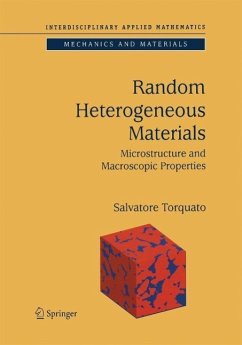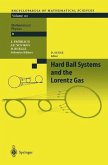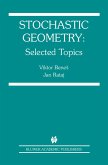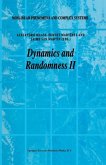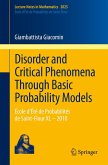The study of random heterogeneous materials is an exciting and rapidly growing multidisciplinary endeavor. This field demands a unified rigorous means of characterizing the microstructures and macroscopic properties of the widely diverse types of heterogeneous materials that abound in nature and synthetic products. This book is the first of its kind to provide such an approach. Emphasis is placed on foundational theoretical methods that can simultaneously yield results of practical utility.
The first part of the book deals with the quantitive characterization of the microstructure of heterogeneous materials. The second part of the book treats a wide variety of macroscopic transport, electromagnetic, mechanical, and chemical properties of heterogeneous materials and describes how they are linked to the microstructure of model and real materials. Contemporary topics covered include the statistical mechanics of many-partical systems, the canonical n-point correlation function, percolation theory, computer-simulation methods, image analyses and reconstructions of real materials, homogenization theory, exact property predictions, variational bounds, expansion techniques, and cross property relations.
This clear and authoritative volume will be of particular interest to graduate students and researchers in applied mathematics, physics, chemistry, material sciences, engineering, geophysics, and biology. Moreover, the book is self-contained and approachable by nonspecialist.
Salvatore Torquato is a professor in the Department of Chemistry and in the Materials Institute at Princeton University. He also holds affiliated appointments at Princeton University in applied and Computational Mathematics Program and in Chemical Engineering. Among other honors, he was a John Simon Guggenheim Fellow in 1998. He has published over two hundred journal articles across a variety of scientific disciplines.
The first part of the book deals with the quantitive characterization of the microstructure of heterogeneous materials. The second part of the book treats a wide variety of macroscopic transport, electromagnetic, mechanical, and chemical properties of heterogeneous materials and describes how they are linked to the microstructure of model and real materials. Contemporary topics covered include the statistical mechanics of many-partical systems, the canonical n-point correlation function, percolation theory, computer-simulation methods, image analyses and reconstructions of real materials, homogenization theory, exact property predictions, variational bounds, expansion techniques, and cross property relations.
This clear and authoritative volume will be of particular interest to graduate students and researchers in applied mathematics, physics, chemistry, material sciences, engineering, geophysics, and biology. Moreover, the book is self-contained and approachable by nonspecialist.
Salvatore Torquato is a professor in the Department of Chemistry and in the Materials Institute at Princeton University. He also holds affiliated appointments at Princeton University in applied and Computational Mathematics Program and in Chemical Engineering. Among other honors, he was a John Simon Guggenheim Fellow in 1998. He has published over two hundred journal articles across a variety of scientific disciplines.
Dieser Download kann aus rechtlichen Gründen nur mit Rechnungsadresse in A, B, BG, CY, CZ, D, DK, EW, E, FIN, F, GR, HR, H, IRL, I, LT, L, LR, M, NL, PL, P, R, S, SLO, SK ausgeliefert werden.
From the reviews: "This interdisciplinary book is an excellent example of the modern scope of issues of interest to many sciences, namely applied mathematics, physics, chemistry, material science, engineering, geology and biology...This book is to a high degree self-contained...It is the first of its kind to provide a unified rigorous means of characterizing the microstructure and macroscopic properties of the wide class of heterogeneous materials which are distinct in nature. All these circumstances will mean great use of this volume by researchers in different scientific fields, interested in the study of heterogeneous materials, as well as in the preparation of courses for graduate students of corresponding specialties." (Mathematical Reviews) "Since the author has been at the forefront of this research field, he has deep insight into many of the theoretical developments of the past two decades, and as a result has produced an outstanding book with many insightful comments. In my opinion, every serious researcher and advanced graduate student who is interested in heterogeneous materials should have a copy of this book." (Journal of Statistical Physics) "This is an important book, which is recommended to all stochastic geometers as well as spatial statisticians, at least to learn what a leading physicist has to say about stochastic geometry . . . [Many] of the formulas in Part II are perfectly general and make no assumption about the type of microstructure, i.e., they are valid for foams, heterogeneous polymer phases, granular media, colloids, composites, etc. . . . [This] is a book which is very important and which merits great attention in the mathematical-statistical community." (D. Stoyan, Metrika, December 2003) "Random Hetergeneous Materials should become a standard reference for those beginning a study of random hetergeneous media." (Applied Mechanics Reviews) "The book at hand has at least two aims: to bring to the literature the current state of the analytic theory of random heterogeneous structures and to expose the tools that have led to a resurgence of interest in these and related materials. The author is in a very good position to achieve these goals, since he is responsible for much of the recent progress in this subject area, and because of his interest in the study of complex systems. Furthermore, much of the material has not appeared in any previous book on the subject . . . This is a well-written monograph with a high degree of originality. The pedagogy is strong, with most of the mathematical derivations elaborated in detail and without excessive verbiage. Much of the book is written so as to be accessible to specialists and advanced students. The mathematical background required of the reader is not extensive. In fact, a number of open research questions are outlined in the course of presentation. Torquato's book does not contain any exercises, but on the other hand there are many carefully worked out examples and meticulous notes about the history and literature in the field . . . [This book] answers a demand for a long awaited textbook for those who wish to learn about this fascinating and still poorly understood area of condensed matter physics which is sure to remain a focus of intense research activity in the years to come. Torquato's monograph should make an excellent text for self-study or for a graduate course in disordered materials. It will be welcomed by the physical and materials science communities." (Christian Brosseau, Optics & Photonics News, February 2003) "This book ... primarily concerns the mathematical analysis of random structures. This work can serve as a foundation for those who wish to design random heterogeneous structures with specified bulk properties. A major contribution of the book is to clearly and rigorously explain the statistical characterization of the microstructure of these materials ... . An extensive reference list is provided. Random Heterogeneous Materials ... should become a standard reference for those beginning a study of random heterogeneous media." (H.W. Haslach Jr., Applied Mechanics Reviews, 55:4, 2002) "The aim of the book is to give broad information about random heterogeneous materials, particularly based on microstructural and macrostructural properties of the constituent materials. ... The book is well written and might be very useful to researchers working in the area of composite materials and porous media. I, therefore, strongly recommend to personal users and to the institute libraries to keep the book on their shelves." (Hilmi Demiray, Zentralblatt MATH, 988:13, 2002) "This book contains an incredible amount of (nontrivial) results, many of which were first obtained by the author himself (in collaboration with his Princeton group). ... A large number of exact results, too many to summarize here, as well as upper and lower bounds for the effective properties are provided together with an extensive list of references (30 pages). This book should be useful to anybody interested in the quantitative study of complex materials, whatever their origin." (M. Baus, Physicalia, 38:4, 2002)

